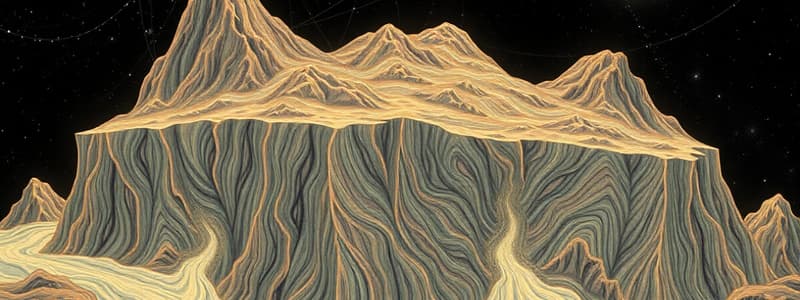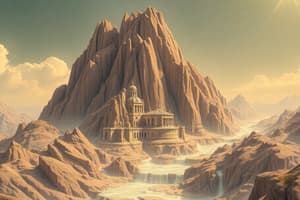Podcast
Questions and Answers
What are the two main layers of the lithosphere?
What are the two main layers of the lithosphere?
The two main layers of the lithosphere are the crust and the upper mantle.
Describe the difference in composition between oceanic crust and continental crust.
Describe the difference in composition between oceanic crust and continental crust.
Oceanic crust is primarily composed of denser basaltic rock, while continental crust is composed of less dense granitic rock.
Explain the concept of plate tectonics and its relationship to the lithosphere.
Explain the concept of plate tectonics and its relationship to the lithosphere.
Plate tectonics is the theory that the Earth's lithosphere is broken into several plates that move and interact with each other. These interactions result in various geological phenomena such as earthquakes, volcanoes, and mountain formation.
What are the three main types of plate boundaries and how do they differ?
What are the three main types of plate boundaries and how do they differ?
How does the lithosphere's composition and structure impact its role in Earth's geological processes?
How does the lithosphere's composition and structure impact its role in Earth's geological processes?
Flashcards
Lithosphere
Lithosphere
The rigid outer layer of Earth, including the crust and upper mantle.
Crust
Crust
The outermost layer of the lithosphere, composed of solid rocks and minerals.
Mantle
Mantle
The layer beneath the crust, made up of semi-solid rock that flows slowly.
Composition of Lithosphere
Composition of Lithosphere
Signup and view all the flashcards
Lithospheric Plates
Lithospheric Plates
Signup and view all the flashcards
Study Notes
Introduction
- The lithosphere is the rigid outer part of the Earth, consisting of the crust and upper mantle.
- It is broken into several large and small tectonic plates that are in constant motion.
- Its structure and composition are crucial to understanding geological processes like earthquakes, volcanoes, and mountain formation.
Lithosphere Composition
- Primarily composed of silicate minerals that vary depending on the specific sections of the lithosphere.
- The crust, the outermost layer, shows significant elemental variations.
- The continental crust is primarily composed of granitoid rocks, like granite and various felsic minerals.
- These are rich in elements such as silicon, aluminum, potassium, and sodium.
- Oceanic crust is primarily composed of basaltic rocks, rich in iron and magnesium.
- The upper mantle, beneath the crust, is predominantly composed of peridotite, an ultramafic rock.
- Minerals in both the crust and upper mantle have varying proportions of oxygen, silicon, and other metallic elements and compounds.
Lithosphere Structure
- The lithosphere is not a homogeneous layer and displays variations in thickness.
- The lithosphere's thickness varies significantly between continental and oceanic regions.
- Continental lithosphere is typically thicker than oceanic lithosphere, usually ranging from 100 to 250 km in depth.
- Oceanic lithosphere is generally thinner, ranging from about 50 to 100 km.
Crustal Structure (within the lithosphere)
- The continental crust is broadly divided into upper and lower layers, distinguished by differences in the composition of their constituent rocks and minerals.
- The upper crust has an average density and chemical differences compared to the lower crust.
- The oceanic crust displays a layered structure influenced primarily by igneous processes and associated cooling.
Mantle Structure (within the lithosphere)
- The upper mantle is a crucial component of the lithosphere.
- It plays a role in convection currents that drive tectonic plate movements.
- The upper mantle is made up of solid rock, with specific minerals that provide rigidity.
- Different layers within the upper mantle contribute to the lithosphere's overall structure with variations in density and mineral content playing a significant role.
Properties of Lithospheric Materials
- The physical properties of materials within the lithosphere (e.g., density, hardness, strength, and elasticity) are crucial to understanding its behavior and response to stress.
- Variations in these properties are linked to the differences in composition and temperature gradients.
- These properties also influence how the lithosphere responds to forces, affecting phenomena like plate tectonics and earthquakes.
Role in Plate Tectonics
- The lithosphere is broken into several large and small plates
- These plates float on the underlying asthenosphere (part of the mantle) and are constantly in motion relative to each other.
- The lithosphere's structure and composition significantly influence the behavior of these plates.
Geological Processes
- Processes such as mountain building, earthquakes, and volcanic activity are directly related to the dynamic nature of the lithosphere.
- The interaction between plates, driven by mantle convection, leads to these significant processes.
- The composition and strength of the lithosphere's materials are paramount to the outcome of these geologic events.
Studying That Suits You
Use AI to generate personalized quizzes and flashcards to suit your learning preferences.




